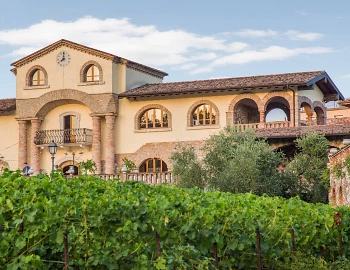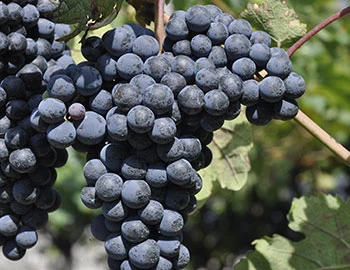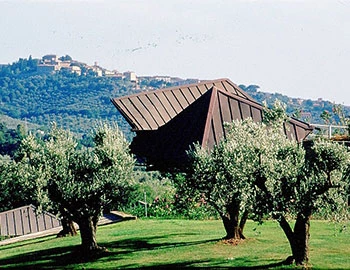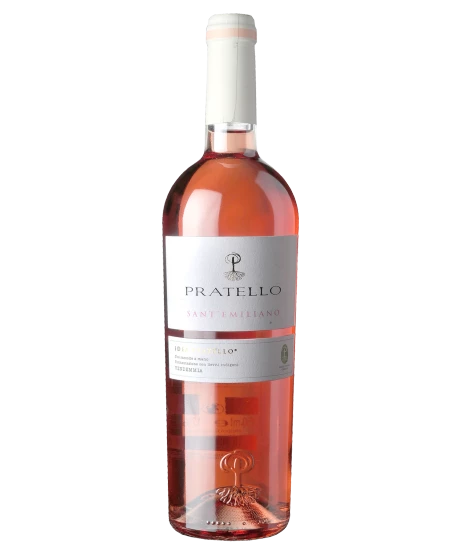Sant'Emiliano 2023
Chiaretto Valtenesi DOC, Azienda Agricola Pratello, 750 ml

Description
Lake Garda feeling
For five generations now, the Pratello family has been passionately dedicated to wine and sustainable agriculture. The Sant'Emiliano rosé with the Chiaretto Valtenesi designation of origin is characterised by a cuvée of indigenous grape varieties such as Gropello, Marzemino and Barbera.
This rosé is characterised by a delicate structure with intense aromas: Wild berries and flint on the nose and juicy cherry fruit on the palate, straight and powerful.
A Chiaretto that definitely knows how to shine – whether served with food or simply enjoyed on its own.
Attributes
| Origin: | Italy / Lombardia |
| Grape variety: | Gropello, Marzemino, Barbera |
| Label: | Vegan |
| Ripening potential: | 1 to 4 years |
| Drinking temperature: | 10 to 12 °C |
| Food Pairing: | Apéro pastries, Vegetable dip, Salad with vegetables, pulses, pasta, Pizza or Flammkuchen, Vegetable cous-cous, Seafood salad |
| Vinification: | short must fermentation, fermentation at low temperatures |
| Harvest: | hand-picking |
| Maturation: | in steel tank |
| Bottling: | filtration |
| Volume: | 12.5 % |
| Note: | Contains sulphites |
Azienda Agricola Pratello
In Padenghe sul Garda, a small medieval village at the south-western end of Lake Garda, lies the traditional but also progressive Azienda Agricola Pratello.
Vincenzo Bertola directs this agricultural estate, which comprises a total of 100 hectares. 45 hectares of which are planted with vines. In addition, olives, cereals, vegetables and fruit are also grown. Forests and pasture land, on which an Alpaca herd frolics, form part of this estate. The soil, mainly moraine soil with some clay, is loose, stony and dates back to the glacial period. The climate is generally mild and is under the influence of the nearby lake.

Azienda Agricola Pratello
In Padenghe sul Garda, a small medieval village at the south-western end of Lake Garda, lies the traditional but also progressive Azienda Agricola Pratello.
Vincenzo Bertola directs this agricultural estate, which comprises a total of 100 hectares. 45 hectares of which are planted with vines. In addition, olives, cereals, vegetables and fruit are also grown. Forests and pasture land, on which an Alpaca herd frolics, form part of this estate. The soil, mainly moraine soil with some clay, is loose, stony and dates back to the glacial period. The climate is generally mild and is under the influence of the nearby lake.

Azienda Agricola Pratello
In Padenghe sul Garda, a small medieval village at the south-western end of Lake Garda, lies the traditional but also progressive Azienda Agricola Pratello.
Vincenzo Bertola directs this agricultural estate, which comprises a total of 100 hectares. 45 hectares of which are planted with vines. In addition, olives, cereals, vegetables and fruit are also grown. Forests and pasture land, on which an Alpaca herd frolics, form part of this estate. The soil, mainly moraine soil with some clay, is loose, stony and dates back to the glacial period. The climate is generally mild and is under the influence of the nearby lake.

Azienda Agricola Pratello
In Padenghe sul Garda, a small medieval village at the south-western end of Lake Garda, lies the traditional but also progressive Azienda Agricola Pratello.
Vincenzo Bertola directs this agricultural estate, which comprises a total of 100 hectares. 45 hectares of which are planted with vines. In addition, olives, cereals, vegetables and fruit are also grown. Forests and pasture land, on which an Alpaca herd frolics, form part of this estate. The soil, mainly moraine soil with some clay, is loose, stony and dates back to the glacial period. The climate is generally mild and is under the influence of the nearby lake.

Marzemino
Mozart’s Inspiration
Around 20 different grape varieties are cultivated in Trentino, Italy, all of which provide extremely varied wines. The red Marzemimo also originates from these vineyards, and it is a grape which even found its way into opera. Wolfgang Amadeus Mozart stayed frequently in Trentino, and he loved the dark red wines pressed from Marzemino so much that he composed a memorial to the wine for his opera Don Giovanni. His Marzemino aria begins, “Versa il vino! Eccelente Marzemino.”
This inspiring vine has been cultivated since at least Roman times, and its home is surely Italy. While it has been alleged that the grape stems from an Austrian village called Marzemin, there is no such village

Italy
Italy – Where wine is a way of life
The Italian wine regions are extremely diverse, and this is made clear in their wines. Established varieties such as Merlot, Syrah, and Sauvignon can be found on just 15 percent of the total vine growing area. The remaining 85 percent is reserved for autochthonous, indigenous varieties. More than 2,000 different grape varieties are grown under diverse conditions and pressed with various techniques into wines that reach the top tier of the international wine market.



